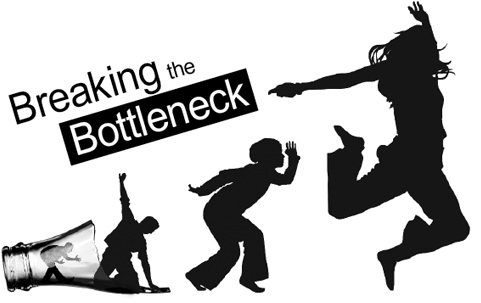At the upcoming XIX International AIDS Conference here in Washington D.C., I’ll be joining REPSSI (the Regional Psychosocial Support Initiative) as they celebrate their decade-long work to lessen the devastating social and emotional (psychosocial) impact of poverty, conflict, HIV and AIDS among children and youth across East and Southern Africa.
 In preparation, I am re-reading this 2005 Save the Children UK publication, “Bottlenecks & drip-feeds: Channelling resources to communities responding to orphans and vulnerable children in Africa.”
In preparation, I am re-reading this 2005 Save the Children UK publication, “Bottlenecks & drip-feeds: Channelling resources to communities responding to orphans and vulnerable children in Africa.”
In it the author Dr. Geoff Foster argues that what stops the smooth flow of aid funds to support indigenous, community-level initiatives are:
1) Providing resources to communities is not taken seriously at global and national levels,
2) Current risk-averse funding mechanisms do not allow for resource ‘flows’ that reach community-based organizations, and
3) Donors and governments are not held accountable for spending to support community initiatives.
It leaves me wondering, in the seven years since this was written, how much has changed?
As community-based and -focused institutions, grassroots organizations are still part of the social fabric of the community in which girls and boys live and grow. They are still uniquely positioned to serve and be led by vulnerable, unreached, and marginalized children. Grassroots organizations are still most often the “first responders,” addressing children’s and families’ immediate and long-term needs. When election-related violence breaks out, an earthquake hits, or a case of abuse is discovered, grassroots organizations still snap into action to make sure kids are safe and cared for, demonstrating a resourcefulness and commitment to children that stems from their “staying power” at the local level.
This intimate position within girls’ and boys’ lives and in the community enables grassroots organizations to (1) have the legitimacy and trust to reach marginalized and isolated children with supportive and appropriate care, (2) design programs that are deemed most necessary and sensible in their locality, and (3) use their expertise to influence local support systems and institutions (e.g. families, schools, etc.) to more adequately fulfill children’s rights.
This is why seven years later I still want to see more well-resourced mechanisms that reach under-funded grassroots organizations with unrestricted small grants. When it comes to children, these grassroots leaders are the real experts.
Among us 25,000+ “experts” who will be gathered in D.C. later this month, is our lack of humility what really stops the smooth flow of funds?

***
Related Posts
The Case of the Missing Tomato Cages
“With the available resources we had…”
What’s missing from the aid effectiveness debate? Overlooking the capacity of local organizations
Reaching Girls at the Grassroots – A Sound Investment (Part 2)
Trocaire: 10 things INGOs need to do
The wisdom of dlalanathi: Reflections on organizational growth


I think if the aid providers worked with NGOs, charities and individuals from some of the countries where aid goes it may work. There are very many individuals from these countries residing in developed countries (the main source of aid) who would guide the flow of aid funds but some governments, mainstream agencies and international NGOs still want to work with governments directly thus delaying and denying aid.
absolutely correct……1. legitimacy and trust, 2. good programmes designing n stimulating local support system are the key factors which will change the scenario. I would add couple of factors (a) Transparency n accountability at all level and (b) Innovative use of leadership quality of community members/grass root organisation
Community-based-organisations(CBOs) are not always community based unless they are community led and community driven. Often they are urban (elite)led and driven and community defined as beneficiaries. Until the said community is the driver, the leader and the owner of the CBO, we should continue to expect too little too late.
Secondly, CBOs are poorly structured and the initiatives not locally institutionalised, let alone sustainable.
Third, most community efforts, like what you have touched in the article come in the form of relief or emergency support and have no long-term vision and mission.
You are absolutely right @Kerre in pointing out that not all local organizations are created alike and that we should not conflate local organizations with local communities. However, you and I have had a very different experience in working with grassroots organizations. I maintain that local indigenous organizations that are embedded in the communities they serve are better suited to assess and respond to person-to-person needs on a long-term basis than larger agencies. See: http://www.how-matters.org/2011/10/05/overlooking-the-capacity-of-local-organizations/
The general (and often pejorative and disparaging) assumption in the development sector that the capacity of “local implementing partners” should be measured by the degree of formal structure and the differentiation of organizations is something that must be re-examined. Though “informal”, local groups often lack the required accountability mechanisms and sophisticated processes that would make them more recognizable, esteemed, or “fundable” in the sector, but they have a range of capacities and competencies that also distinguish them from other civil society actors, like responsiveness to the community’s immediate needs. You can read more at: http://www.hiidunia.com/2010/08/understanding-organizational-development-within-community-based-organizations/
It is certainly possible for diligent and thoughtful donors to separate the wheat from the chaff. I am concerned, however, that this so-called “lack of capacity” is used to justify many antiquated practices in the aid industry.
Aid effectiveness is debated issue,who is responsible for non-effectiveness of aid? Certainly, the first one is donors and secondly the implementing organization. In most case, Aid provided through bidding process. What does it mean? Evaluation of bid is done based on merit of technical and financial proposal ignoring the capacity and commitment to reach the goal of aid. Project based funding has specific duration. it means whatever you do, you have to complete within the time-frame. The bidding system itself has commercial connotation, instead of development, the implementing organizations are doing development business. it is the hindrance for aid effectiveness. Coming out from the commercial process, Aid has to be humanized, and humanization of development can ensure its effectiveness.